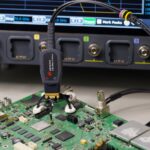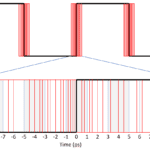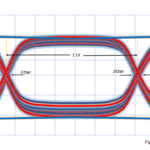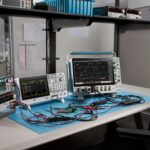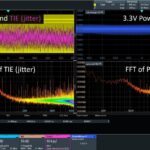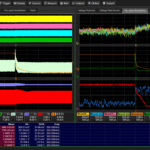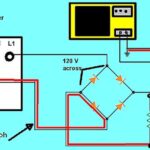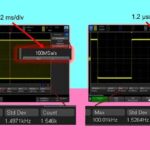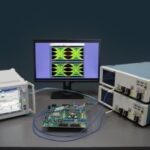The Infiniimax 4 active probe from Keysight reaches 52 GHz, enough to see signals on PCIe 6/7, 800 Gb/sec Ethernet, DDR 5/6, and other high-speed serial buses. Oscilloscopes with 100 GHz and higher bandwidths can display signals on 224 Gb/sec PAM4 serial buses and they’ve been available for several years. Without probes of high enough […]
oscilloscope measurements
What is jitter and what can I do about it (part 2 of 2)?
Operations on acquired jitter data help quantify jitter values. Part 1 of this article described the oscilloscope eye diagram and unit interval (UI) and focused on a single ideal rising edge with 28 additional edges representing some degree of jitter (Figure 1). We determined the peak-to-peak jitter to be 15 ps, based on the edges […]
What is jitter and what can I do about it (part 1 of 2)?
Measuring and quantifying jitter are the first steps toward controlling it. Jitter is a measure of the timing performance of a digital data stream such as Ethernet, USB, PCIe, or HDMI. It defines when data transitions occur in relation to an ideal waveform. Excess jitter can lead to signal-integrity problems that result in high bit-error […]
Automate double-pulse testing in WBG devices
By automating double-pulse testing of wide bandgap devices such as SiC and GaN power devices, you can cut setup and analysis time. The need to reduce carbon emissions drives investments in electrical technologies, particularly in data centers and electric vehicles. In its most recent Elective Vehicle Outlook report, Bloomberg estimates a 27% increase in global […]
How to make fast and accurate power-integrity measurements
Today’s electronic devices with fast FPGAs, ASICs, and other ICs rely on ever-smaller power rail voltages with tight tolerances. Engineers who incorporate these ICs into their systems need to use oscilloscopes, probes, and measurement techniques that align with today’s tight voltage rail tolerances. Making an accurate ripple measurement with an oscilloscope on a 1 V […]
Measurements verify power integrity
Engineers should measure and analyze power integrity on the power and ground planes of a board’s power distribution network. Understanding power integrity is crucial when evaluating circuit power quality because it has a direct influence on performance. Power integrity is a subset of signal integrity, whose assessment ensures that signals have suitable amplitude, rise time, […]
The perils of oscilloscope ground and power ground
Most electrical engineers probably are aware that connecting the ground connection for ordinary oscilloscope probes to the wrong part of an ac power line will invite a lot of trouble. Unfortunately the remedies sometimes employed to head off difficulties can cause their own woes. In a lab where I was once employed, the instrument carts […]
How to run video games on an oscilloscope
Spend enough time on YouTube and you’ll uncover numerous videos showing some kind of video game being played on an oscilloscope. The most popular game choices for these videos seem to be the old Doom and Quake games and Pong, the first real video game released in 1972. Perhaps the main reason for Doom’s popularity […]
Making better oscilloscope measurements through horizontal and vertical scaling
Early oscilloscope models were primitive by modern standards. Among the first major innovations was triggered sweep, introduced by Tektronix just in time for the post-World War Two electronics boom. This improvement in waveform imaging synchronized successive periodic waveforms to create a coherent image, based on a uniform level along the rising edge or another user-defined […]
PCIe 6.0 transmitter/receiver test setup delivers shorter test times
An intuitive new PCIe 6.0 Receiver Test Solution equips engineers to test PCIe 6.0 (Base) receivers and addresses ever-growing performance demands of the next generation of high performance systems. With this release, Tektronix provides a cohesive PCIe 6.0 transmitter and receiver test solution that delivers faster test times, higher-quality measurements, and an intuitive user interface. […]
